

Catch Fish with
Mike Ladle
Information Page
SEA FISHING
For anyone unfamiliar with the site always check the FRESHWATER, SALTWATER and TACK-TICS pages. The Saltwater page now extends back as a record of over several years of (mostly) sea fishing and may be a useful guide as to when to fish. The Freshwater stuff is also up to date now. I keep adding to both. These pages are effectively my diary and the latest will usually be about fishing in the previous day or two. As you see I also add the odd piece from my friends and correspondents if I've not been doing much. The Tactics pages which are chiefly 'how I do it' plus a bit of science are also updated regularly and (I think) worth a read (the earlier ones are mostly tackle and 'how to do it' stuff).
What about flies?
FLY FISHING FROM THE SHORE
To continue from the previous page. Even today the term "fly" to a sea angler usually means a mackerel feather. Although there have been improvements in design of such lures, modern versions of mackerel attractors are still often much too crude or poorly made to fish properly, or to stick into a fish when using a light, flexible, fly rod.
So, what's the best thing to tie on the end if you want to try fly fishing in saltwater? Fifty-odd years ago, the first flies that my pals and I fished for bass were either "Waddington" type salmon flies or home-made tube flies. Even these, although they had been designed for traditional 'fresh-water fly-fishing' and were better made than traditional feathers, they were often on the large side for sensible fishing on 'trout' gear. So, it was not long before we began to tie flies which were lighter weight and much more effective for bass fishing. In this piece I use pictures from past experiences to compare with more recent activities. Innovations are printed in bold type.
Tube and Waddington type 'salmon' flies. The original things we used for bass.

Of course, at the same time that we were developing bass flies the methods of fly fishing for mullet were being explored. This was a totally different business and the early mullet flies were tied to float and to resemble little white maggots. For "maggot flies" we tried hooks ranging from about size 8 down to size 16. It soon became apparent that it was possible to land not only mullet but also good sized bass on these 'tiny' hooks (yes, bass often eat maggots too). This accidental success encouraged us to refine the bass flies still further.
Basic, floating, polyethylene-foam, maggot flies used for mullet. We've tried many variants but these are still good when baited with maggots.
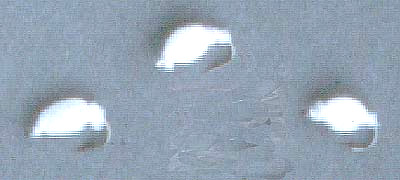
A selection of Mylar tubes on single and treble hooks. Mylar tube looks as much like a small silver fish as any more complex fly.
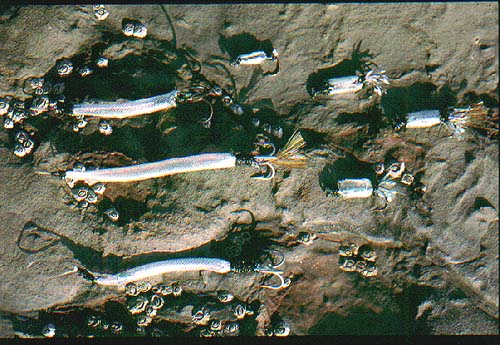
Maggot feeding mullet generally skim the floating food items from the surface, by swimming with their mouths gaping widely. Bass, on the other hand, take a different approach and surface briefly to grab a mouthful of larvae before submerging again. Many maggot-feeding bass are less than a couple of pounds so to tempt the few sizeable fish, which may be present, it is often worth switching to a fry imitation.
Surface-skimming, maggot-feeding mullet.
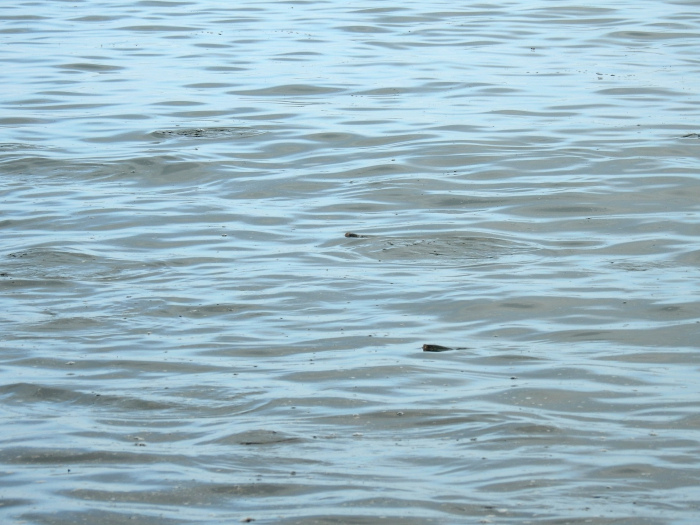
WHOOPEE!! A feast for the fish and just the spot for me to have a cast or two.
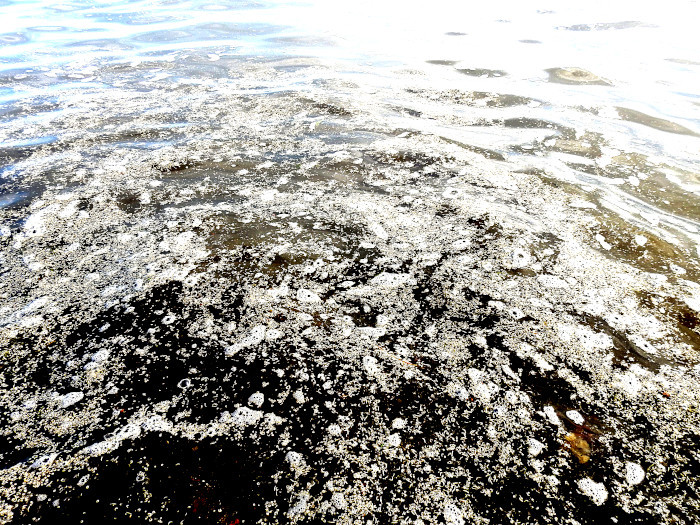
I'm into a good bass tempted from the maggot feast by using a tiny, white, plastic eel.

Back she goes. Note the quantity of loose, 'line-fouling' weed in the water.
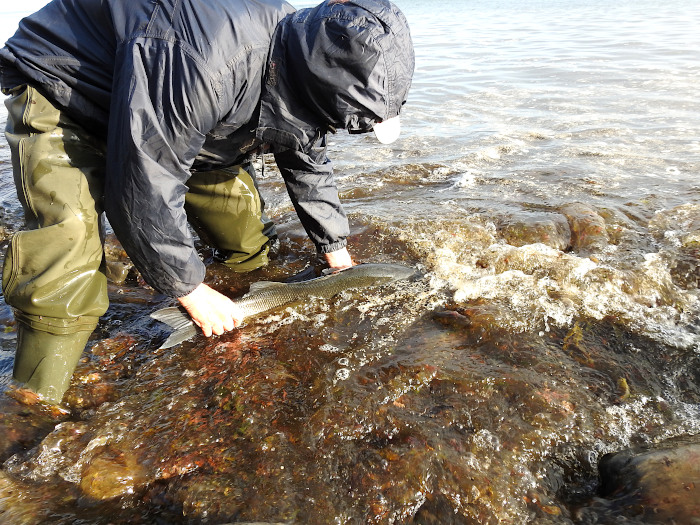
Nowadays, any decent, mail order, fly fishing supplier will list a whole range of "salt water" fish, shrimp and crab imitations (mostly designed for the American/Tropical-sea fishing market) - at a price. It is probably better, certainly cheaper and definitely more satisfying to find or make your own.
If you are as ham fisted as I am, you will find it easier to tie "bass" or "mullet" flies than trout flies and even the least artistic creations are likely to work. If you don't want to embark on a fly tying career, a similar silicone rubber "fish" or even a thin strip of mackerel, slipped onto a size six or eight fine wire hook, will probably out-fish most feather and fur constructions. By far the most efficient "fly" I have tried is simply a small, plastic, Delta (or similar type) eel. These lures have a lot more action than most conventional 'wet flies' and can be obtained in a range of colours (if you must try different colours, but it is of minor importance). I have to say that I've done well with white or off white versions and I have also caught plenty of fish on black eels. Fortunately sea fishing is not yet hidebound by hundreds of years of prejudice, myth and legend like fresh water fly fishing. Hopefully it never will be.
Sandsmelt and 'eel-fly'; the violet iridescence on the eel is typical of many silver baitfish (sprats, mackerel, scad, etc.).

I have just two things to add regarding the use of plastic eels or indeed any other type of fly for use in saltwater - (a)Replace the hooks with stainless alternatives, as normal hooks rust in no time under the dressing materials and (b)A binding of thread on the shank and a dab of superglue stops the eel sliding round the bend and spoiling the action..
Plastic eel with stainless hook bound with thread to give grip.
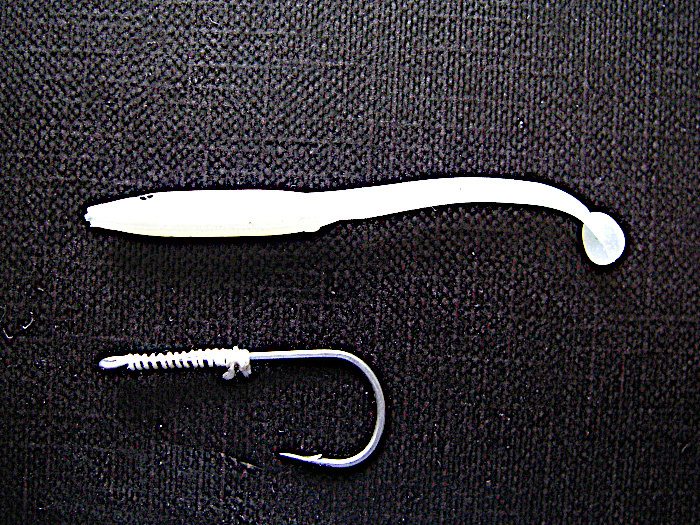
White plastic eel ready for action.
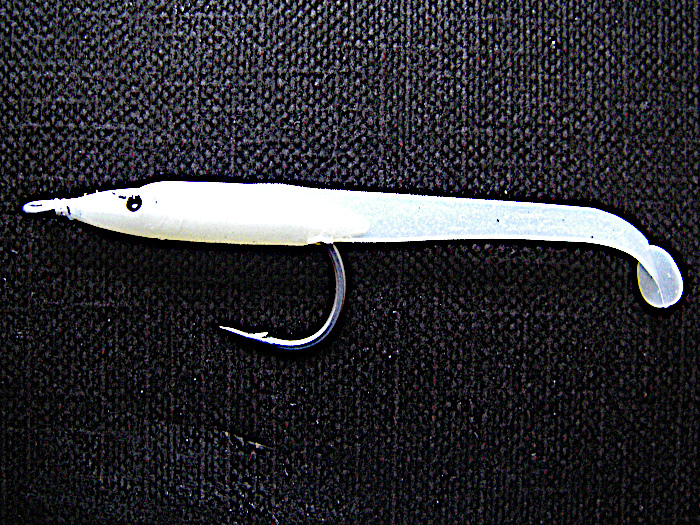
Of course, maggot feeding bass and mullet are by no means the only sea fish you can target with fly tackle. The little plastic eels are very effective and, if you want to try them, tiny soft-plastic shads, fish imitations and conventional 'flies' also 'work' to varying degrees. By far the best time to use these is at dawn and dusk when predatory fish such as mackerel, pollack, scad and bass often follow their prey to the surface, just before the sun rises or as it sets. Scad are the most likely species to bite in full darkness but other species also feed well at the change of light. Spinning tackle will also produce plenty of fish (sometimes larger ones) at these times too, but the fly sport can be hectic and exciting.
A decent pollack on the white eel. I can't fault my Okuma Airframe reel or the Airflo Ridge clear flyline.
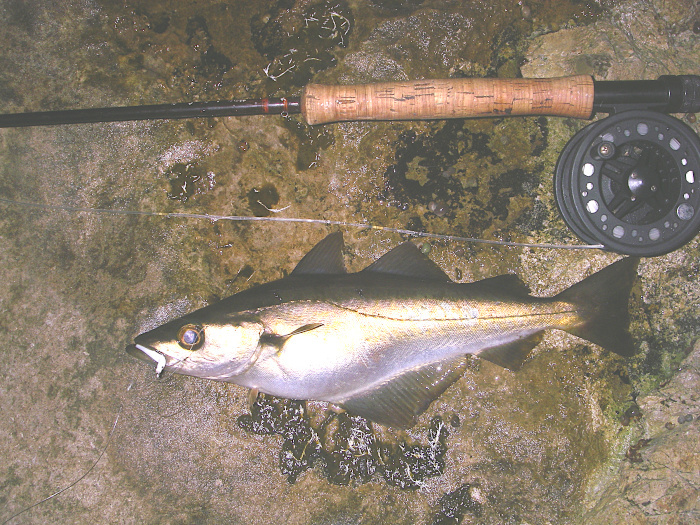
... mackerel like the eels too.
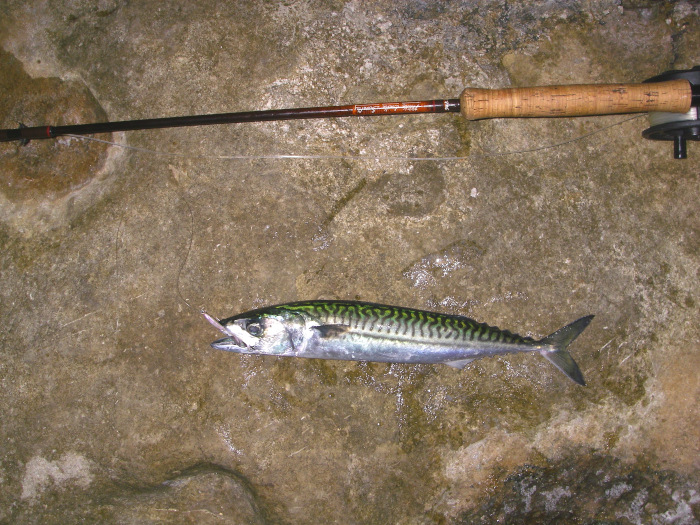
... and school bass.

... and scad (on a different fly but they like eels as well). Often these are the first fish to bite before sunrise and the last after sunset.
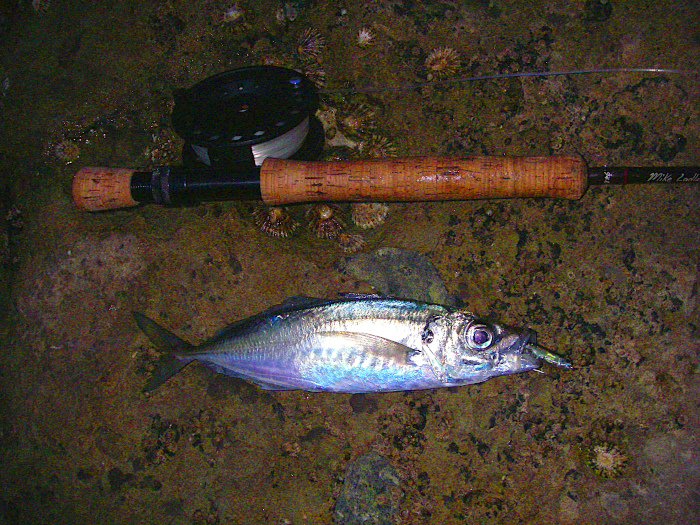
That's about it. When it comes to things like the depth to fish your fly (usually no more than a metre or so), the speed of retrieve (suck it and see) and the best places (try it and find out) and similar details; most of the fun is in giving it a go. Almost all marine species put up a decent battle and if you hook a decent sized mullet or bass, be prepared to give line and play it for five or ten minutes. Next time I shall say something about the changes in spinning gear.
If you have any comments or questions about fish, methods, tactics or 'what have you.'get in touch with me by sending an E-MAIL to - docladle@hotmail.com
– PLEASE TELL YOUR TWITTER, FACEBOOK, EMAIL FRIENDS ABOUT THESE BOOKS.
NEW BOOK
"Fishing for Ghosts - Successful Mullet Angling"
written with David Rigden IT'S AVAILABLE FROM -ALSO THE NEW BOOK
“The Second Wave”
Written with Steve Pitts this is a SEQUEL TO THE BESTSELLER "Operation Sea Angler" IT'S AVAILABLE ON PAPER OR FOR YOUR KINDLE FROM -